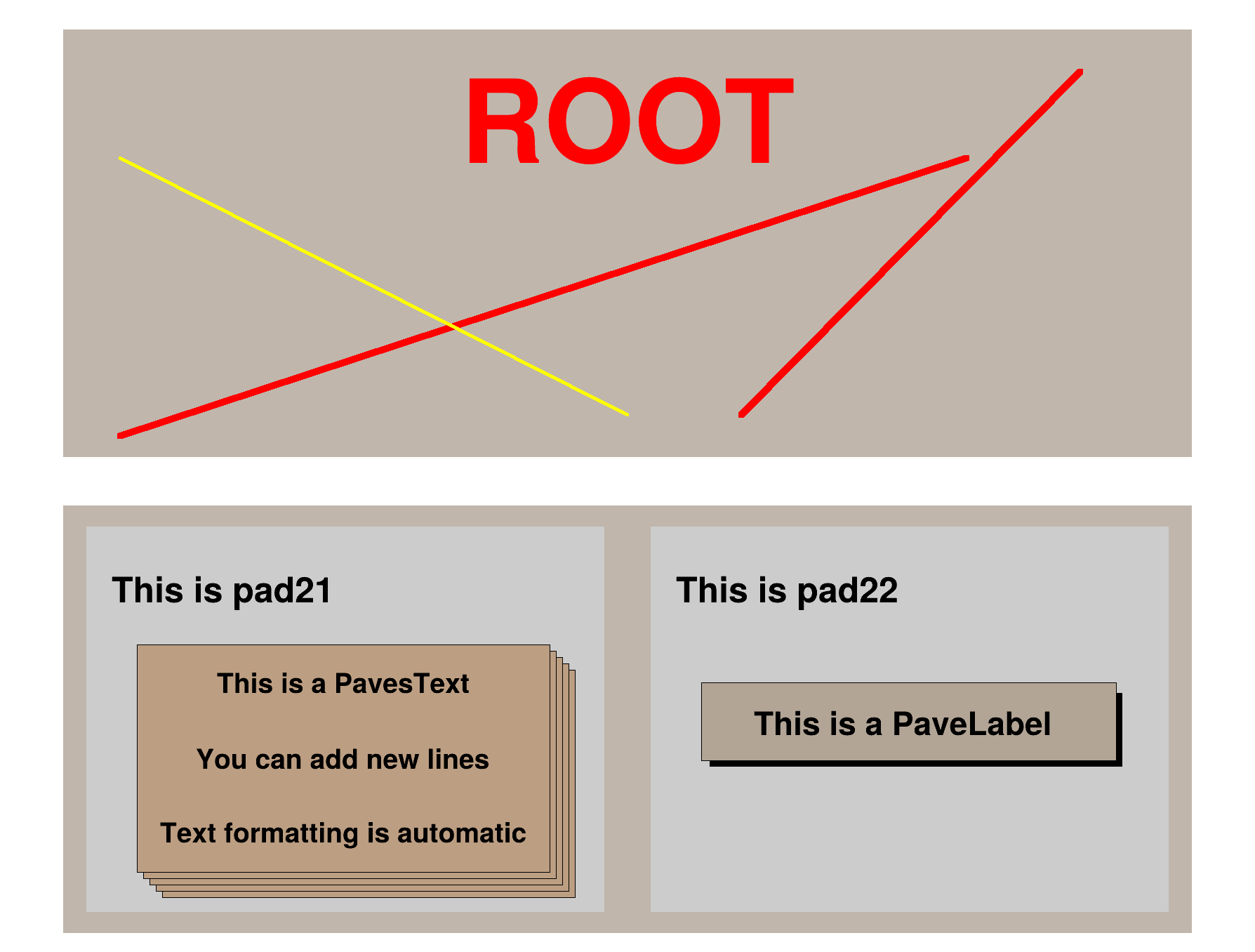

 Example of primitives in a canvas.
Example of primitives in a canvas.
One of the first actions in a ROOT session is the creation of a Canvas. Here we create a Canvas named "c1".
After having executed this macro, try now to point on any object on the screen: pad, text, lines, etc.
When the cursor points to sensitive areas in an object, the cursor shape changes and suggests the type of action that can be applied.
For example:
- One can move, grow,shrink a pad.
- A text can be moved.
- A line can be moved or its end points can be modified.
- One can move, grow and shrink PaveLabels and PavesText.
Point to an object and click the right mouse button to change attributes. Try to change the canvas size.
In the canvas "File" menu, select the option "Print" to produce a PostScript file with a copy of the canvas.

void canvas()
{
TPad *
pad1 =
new TPad(
"pad1",
"This is pad1", 0.05, 0.52, 0.95, 0.97);
TPad *
pad2 =
new TPad(
"pad2",
"This is pad2", 0.05, 0.02, 0.95, 0.47);
TPad *
pad21 =
new TPad(
"pad21",
"First subpad of pad2", 0.02, 0.05, 0.48, 0.95, 17, 3);
TPad *
pad22 =
new TPad(
"pad22",
"Second subpad of pad2", 0.52, 0.05, 0.98, 0.95, 17, 3);
paves->AddText(
"This is a PavesText");
paves->AddText(
"You can add new lines");
paves->AddText(
"Text formatting is automatic");
float t10 =
t1->GetTextSize();
for (
int i = 0; i <
nloops; i++) {
color++;
color %= 8;
}
}
int Int_t
Signed integer 4 bytes (int)
R__EXTERN TBenchmark * gBenchmark
ROOT::Detail::TRangeCast< T, true > TRangeDynCast
TRangeDynCast is an adapter class that allows the typed iteration through a TCollection.
virtual void SetFillColor(Color_t fcolor)
Set the fill area color.
virtual void SetLineWidth(Width_t lwidth)
Set the line width.
virtual void SetLineColor(Color_t lcolor)
Set the line color.
virtual void Start(const char *name)
Starts Benchmark with the specified name.
virtual void Show(const char *name)
Stops Benchmark name and Prints results.
Use the TLine constructor to create a simple line.
virtual TLine * DrawLine(Double_t x1, Double_t y1, Double_t x2, Double_t y2)
Draw this line with new coordinates.
virtual void Draw(Option_t *option="")
Default Draw method for all objects.
The most important graphics class in the ROOT system.
A Pave (see TPave) with a text centered in the Pave.
void Draw(Option_t *option="") override
Draw this pavelabel with its current attributes.
virtual void SetY1NDC(Double_t y1)
virtual void SetY2NDC(Double_t y2)
virtual void SetX1NDC(Double_t x1)
virtual void SetX2NDC(Double_t x2)
A PaveText (see TPaveText) with several stacked paves.
Base class for several text objects.
- Author
- Rene Brun
Definition in file canvas.C.


 Example of primitives in a canvas.
Example of primitives in a canvas. 